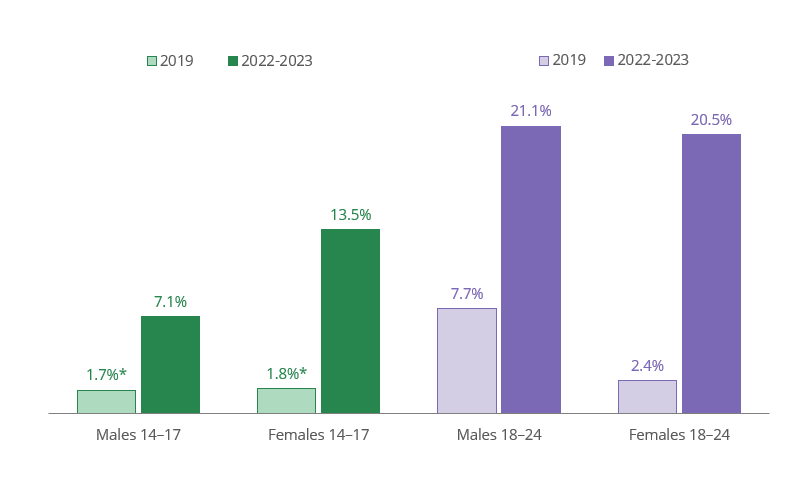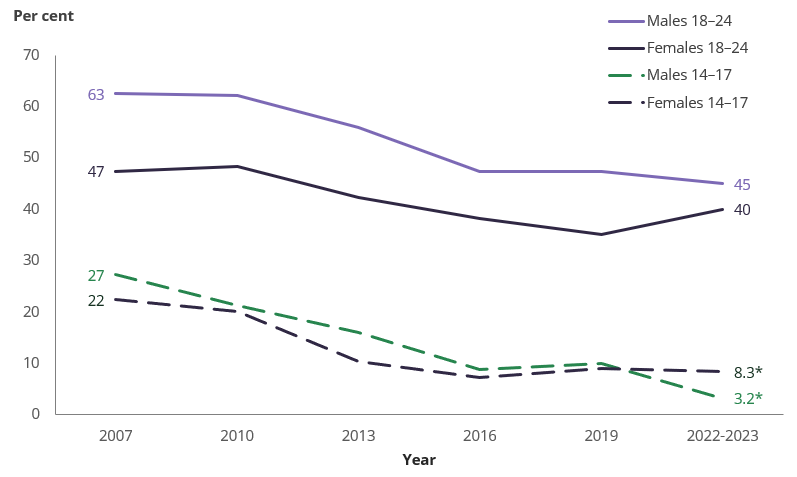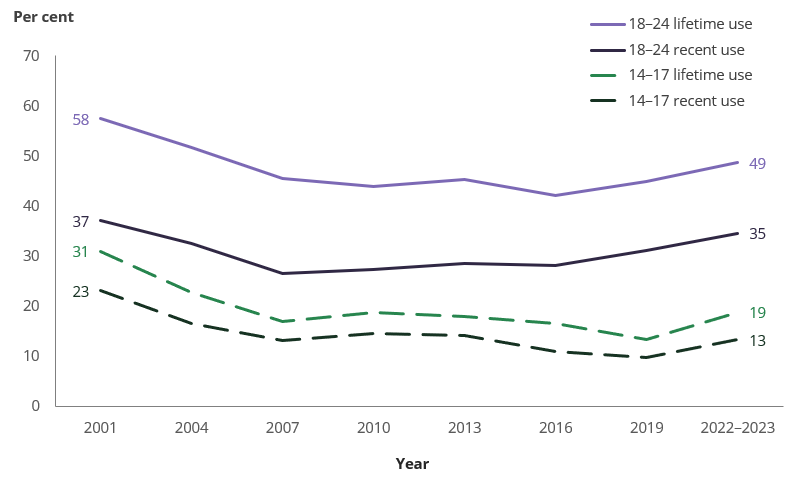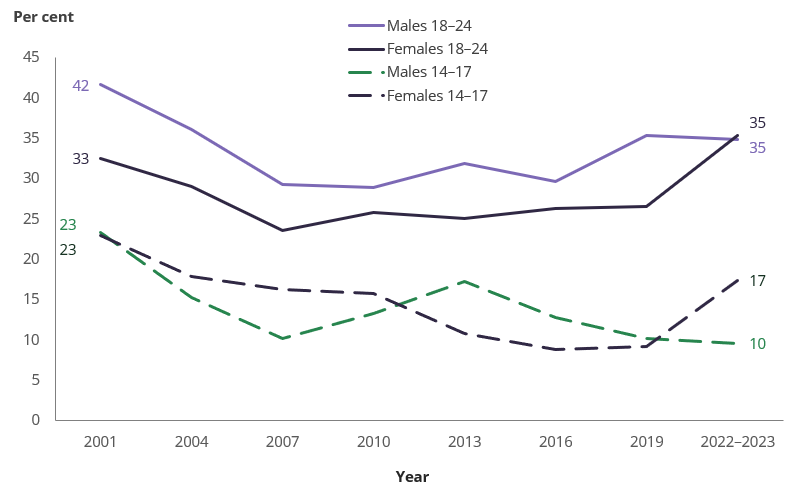Young people in the NDSHS
In Australia, young people (defined between the ages 10 and 24) are identified as one of the priority groups in the National Drug Strategy 2017–2026, as they are more vulnerable to behaviours associated with alcohol, tobacco and other drug related issues which can lead to adverse health and social outcomes (Department of Health and Aged Care, 2017).
The National Drug Strategy Household Survey (NDSHS) collects data from people aged 14 and over from all states and territories. In this article, estimates related to alcohol, tobacco, and other illicit drug use among young people will be drawn from people aged 14–17 and those aged 18–24.
Smoking down and vaping up among young people
In 2022–2023, fewer young people than ever before reported smoking tobacco daily. Only around 10,000 people aged 14–17 smoked daily in Australia in 2022–2023, while around 100,000 people aged 18–24 did so (down from 200,000 in 2019). Consistent with previous years, males aged 18–24 were 1.4 times as likely to smoke daily as females.
In contrast to tobacco, there was a sharp increase in the use of vapes and electronic cigarettes (‘e‑cigarettes’) among young people between 2019 and 2022–2023:
- Among people aged 14–17, current use of e‑cigarettes increased from *1.8% to 9.7%, becoming the age-group with the third-highest proportion of e‑cigarette use.
- People aged 18–24 were the most likely to currently use e‑cigarettes, increasing from 5.3% in 2019 to 21% in 2022–2023.;
In contrast to tobacco, young females were more likely to currently use e‑cigarettes than young males, due to use being substantially higher among females aged 14–17 than among males aged 14–17 (Figure 1). More information on vaping and young people can be found in young people’s use of vapes and e-cigarettes.

* Estimate has a relative standard error between 25% and 50% and should be interpreted with caution.
Source: NDSHS 2022–2023, Table 3.9.
Results from the National Drug Strategy Household Survey do not provide evidence for or against the use of e-cigarettes as a smoking cessation tool, or as a gateway to tobacco smoking. The age groups most likely to smoke tobacco in 2019 and 2022–2023 were the least likely to use e-cigarettes, and the age groups most likely to use e-cigarettes had low tobacco smoking rates in 2019 and 2022–2023.
Young males less likely to consume alcohol at risky levels
The proportion of people drinking alcohol at risky levels (consuming more than 10 standard drinks per week on average, or more than 4 standard drinks in a single day at least once a month) remained stable across almost all age groups between 2019 and 2022–2023. This was also true among people aged 18–24, with 42% consuming alcohol at risky levels in both survey years.
There was however a decline in the proportion of people aged 14–17 who consumed alcohol at risky levels, from 9.5% to just 5.5% in 2022–2023. While this is a positive outcome, the Australian guidelines to reduce health risks from drinking alcohol (NHMRC 2020) state that people under the age of 18 should refrain from drinking any alcohol. In 2022–2023, 31% of people aged 14–17 had consumed alcohol in the previous 12 months, a similar proportion to 2019 (30%).
More information on alcohol consumption among young people can be found in young people’s consumption of alcohol.
While risky drinking among people aged 18–24 was stable at the national level, there were differences by gender. The gap in risky alcohol consumption between young males and young females (45% compared to 40% in 2022–2023) was the smallest seen since the data series began in 2007 (Figure 2).

* Estimate has a relative standard error between 25% and 50% and should be interpreted with caution.
Source: NDSHS 2022–2023, Table 4.28.
Use of illicit drugs remains highest among young people
In 2022–2023, around 1 in 3 people aged 18–24 (35%) or around 800,000 people had used an illicit drug in the previous 12 months, and almost 1 in 2 (49%) or around 1.1 million people in this age group had done so at some point in their lifetime. This is consistent with previous years, as people aged 18–24 have had higher rates of illicit drug use than the rest of the population since 2001.
People aged 14–17 were less likely to have used an illicit drug in the previous 12 months than people aged 18–24, with 13.3% (or around 200,000 people) having done so. However, there was an increase in the proportion of people aged 14–17 who had used an illicit drug in their lifetime, from 13.4% in 2019 to 18.8% in 2022–2023. This is the first time since 2001 that lifetime illicit drug use has increased among people aged 14–17, breaking a downward trend since 2010 when 18.7% had done so (Figure 3).

Lifetime use refers to the use of at least 1 of 17 classes of illicit drugs in their lifetime in 2022–2023. The number and type of illicit drug varied over time.
Recent use refers to the use of at least 1 of 17 classes of illicit drugs in the previous 12 months in 2022–2023. The number and type of illicit drug varied over time.
Source: NDSHS 2022–2023, Tables 5.4 and 5.8.
Illicit use of drugs higher among young females than young males for the first time
Between 2019 and 2022–2023, the proportion of young males who had recently used illicit drugs remained stable (Figure 4). There were however substantial increases in the recent use of illicit drugs among young females, for both those aged 14–17 and those aged 18–24. As a result, for the first time in the NDSHS, young females aged 18–24 were as likely as males of the same age to have used illicit drugs in the previous 12 months.

(a) Used at least 1 of 17 classes of illicit drugs in the previous 12 months in 2022–2023. The number and type of illicit drug varied over time.
Source: NDSHS 2022–2023, Table 5.8.
The higher rate of illicit drug use among young females was reflected in the most commonly used drugs. For example:
- There was a substantial increase in the recent use of cannabis between 2019 (20%) and 2022–2023 (26%) among females aged 18–24. Females aged 14–17 were more likely to have recently used cannabis (12.9%) than males in the same age range (*6.8%).
- Recent use of cocaine increased among females aged 18–24 between 2019 (8.0%) and 2022–2023 (11.9%), resulting in slightly higher use among females than males of the same age (11.2%).
* Estimate has a relative standard error between 25% and 50% and should be interpreted with caution.
These changes among young females mark a major shift in the use of illicit drugs, as well as the use of e‑cigarettes and risky drinking of alcohol. Future surveys will need to monitor this trend, to understand whether it represents a long-term shift in the use of illicit drugs among young people.
Which illicit drugs were most likely to be used by young people?
While the National Drug Strategy refers to young people (10–24) as a priority population group, the patterns of drug use are very different between 14–17 and 18–24 year olds (Table 1). While young people in both age groups were most likely to have used cannabis, the next most commonly used drugs among people aged 18–24 were cocaine and ecstasy, while for people aged 14–17 they were inhalants and pharmaceuticals used for non‑medical purposes.
People aged 14–17 2019 | People aged 14–17 2022–2023 | People aged 18–24 2019 | People aged 18–24 2022–2023 |
|---|
Marijuana/cannabis (8.2%) | Marijuana/cannabis (9.7%) | Marijuana/cannabis (25%) | Marijuana/cannabis (25.5%) |
Inhalants (*1.8%) | Inhalants (*2.2%) | Ecstasy (10.8%) | Cocaine (11.3%) |
Ecstasy (*1.2%) | Pain-relievers and opioids(a) (*1.6%) | Cocaine (10.8%) | Ecstasy (6.7%) |
Hallucinogens (*1.1%) | Pharmaceutical stimulants(a) (*1.0%) | Hallucinogens (5.2%) | Hallucinogens (6.4%) |
Tranquillisers/Sleeping pills(a) (*0.7%) | Hallucinogens (*0.9%) | Inhalants (5.2%) | Inhalants (5.2%) |
* Estimate has a relative standard error between 25% and 50% and should be interpreted with caution.
(a) Used for non‑medical purposes.
Notes:
1. Decreases in ecstasy use may be due to limited availability following COVID-19 related health measures.
2. Pharmaceutical stimulants were introduced in the 2022–2023 NDSHS.
Source: NDSHS 2022–2023, Tables 5.50, 5.65, 5.73, 5.97, 5.116, 6.9, 6.19 and 6.23.
These differences indicate that the potential risks and harms that young people may experience from illicit drugs are likely to differ between those under 18 and those aged 18 to 24.


